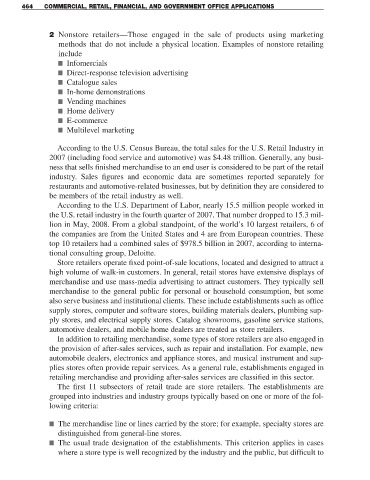Page 486 - Solid Waste Analysis and Minimization a Systems Approach
P. 486
464 COMMERCIAL, RETAIL, FINANCIAL, AND GOVERNMENT OFFICE APPLICATIONS
2 Nonstore retailers—Those engaged in the sale of products using marketing
methods that do not include a physical location. Examples of nonstore retailing
include
■ Infomercials
■ Direct-response television advertising
■ Catalogue sales
■ In-home demonstrations
■ Vending machines
■ Home delivery
■ E-commerce
■ Multilevel marketing
According to the U.S. Census Bureau, the total sales for the U.S. Retail Industry in
2007 (including food service and automotive) was $4.48 trillion. Generally, any busi-
ness that sells finished merchandise to an end user is considered to be part of the retail
industry. Sales figures and economic data are sometimes reported separately for
restaurants and automotive-related businesses, but by definition they are considered to
be members of the retail industry as well.
According to the U.S. Department of Labor, nearly 15.5 million people worked in
the U.S. retail industry in the fourth quarter of 2007. That number dropped to 15.3 mil-
lion in May, 2008. From a global standpoint, of the world’s 10 largest retailers, 6 of
the companies are from the United States and 4 are from European countries. These
top 10 retailers had a combined sales of $978.5 billion in 2007, according to interna-
tional consulting group, Deloitte.
Store retailers operate fixed point-of-sale locations, located and designed to attract a
high volume of walk-in customers. In general, retail stores have extensive displays of
merchandise and use mass-media advertising to attract customers. They typically sell
merchandise to the general public for personal or household consumption, but some
also serve business and institutional clients. These include establishments such as office
supply stores, computer and software stores, building materials dealers, plumbing sup-
ply stores, and electrical supply stores. Catalog showrooms, gasoline service stations,
automotive dealers, and mobile home dealers are treated as store retailers.
In addition to retailing merchandise, some types of store retailers are also engaged in
the provision of after-sales services, such as repair and installation. For example, new
automobile dealers, electronics and appliance stores, and musical instrument and sup-
plies stores often provide repair services. As a general rule, establishments engaged in
retailing merchandise and providing after-sales services are classified in this sector.
The first 11 subsectors of retail trade are store retailers. The establishments are
grouped into industries and industry groups typically based on one or more of the fol-
lowing criteria:
■ The merchandise line or lines carried by the store; for example, specialty stores are
distinguished from general-line stores.
■ The usual trade designation of the establishments. This criterion applies in cases
where a store type is well recognized by the industry and the public, but difficult to

